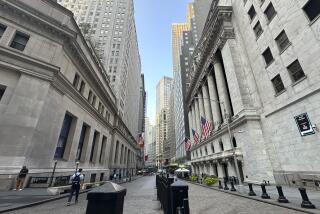Gains in Economic Index Point to Stronger Growth
- Share via
WASHINGTON — Hinting at stronger economic growth ahead, the government’s index of leading indicators climbed 0.7% in May for the fourth monthly advance in a row, while civilian factory orders rose a healthy 0.8%, according to Commerce Department figures released Tuesday.
Meanwhile, two top Reagan Administration officials issued stern warnings to the Federal Reserve Board that a tight money policy and higher interest rates might bring an end to the 4 1/2-year-old economic recovery.
Their statements suggest that the Reagan Administration, which has generally shied away from attacking the Fed in recent years, may feel freer to try to influence monetary policy now that veteran Chairman Paul A. Volcker is scheduled to be replaced later this summer by Alan Greenspan, who was nominated by Reagan to head the central bank in early June.
Beryl W. Sprinkel, the White House’s chief economic adviser, told a congressional committee that he wanted to “emphasize” that if the recent slowdown in the growth of the money supply “continued for several more quarters, (it) could place the continuation of reasonable growth of real output and employment at risk.”
Sprinkel’s remarks were echoed by Commerce Secretary Malcolm Baldrige, who warned in a statement that “tight credit conditions would limit” economic growth that had been projected at 3% to 4% over the next several months.
The Fed squeezed the money supply slightly in April to help stabilize the value of the dollar and to squelch fears of rising inflation. Both Sprinkel and Baldrige appeared to be advocating that the Fed avoid further credit-tightening moves that might cause a recession. A recession next year could wreck Republican hopes of retaining the White House in the 1988 election.
Economists, however, warned that higher interest rates, which contributed to May’s sharp 14.9% drop in housing starts, may be inevitable over the next few months.
“They used to say that all roads lead to Rome, but now I think all roads are leading to higher interest rates,” said Irwin Kellner, chief economist at Manufacturers Hanover Bank in New York. “With economic growth improving, higher inflation and oil prices, and the need for Greenspan to establish himself as an inflation fighter, I don’t see how higher rates are avoidable.”
Although most analysts think economic growth slowed during the second quarter that ended Tuesday after the sharp 4.8% gain for the first three months of the year, the latest economic statistics point to a strengthening in the economy for the rest of 1987.
“The net gain in the leading index over the past six months--an annual rate of 7.4%--is consistent with near-term growth of 3% to 4% in the economy,” Baldrige said.
The May increase of 0.7% was the strongest since a 0.9% advance in March. At the same time, a sharp upward revision for April reversed the earlier report of a 0.6% drop for that month to a 0.2% gain.
The index, while unreliable on a month-to-month basis, serves as the government’s chief barometer of future economic performance. It has advanced every month this year except for January, when it dropped by 0.6% largely because of special factors related to tax revision.
Also encouraging was the 0.8% gain in civilian factory orders, which suggested that improvements in foreign trade are likely to outweigh domestic weakness in the U.S. economy that has contributed to slowing auto sales and slumping housing starts.
“The economy is shifting gears from a consumer-led expansion to an export-driven recovery,” as the declining value of the dollar has made U.S. goods more competitive on world markets, said W. Lee Hoskins, chief economist at Pittsburgh National Bank. “As a result, the economy is likely to keep rolling along for quite a while.”
The strength in civilian factory orders was offset by a sharp drop in defense orders, which tend to fluctuate widely, leaving the overall level of new orders for manufactured goods unchanged in May from the previous month at a seasonally adjusted $200.6 billion.
Looking at the leading indicators, the main sources of strength were related to the apparent improvement in manufacturing, with hours worked at factories, plant and equipment spending, business delivery times and changes in raw material prices all reflecting stronger growth. Other indicators--such as a drop in building permits, slower money supply growth, a rise in unemployment claims, a drop in stock prices--held back the advance in the index.
More to Read
Inside the business of entertainment
The Wide Shot brings you news, analysis and insights on everything from streaming wars to production — and what it all means for the future.
You may occasionally receive promotional content from the Los Angeles Times.










